Barber J.R. Intermediate Mechanics of Materials
Подождите немного. Документ загружается.

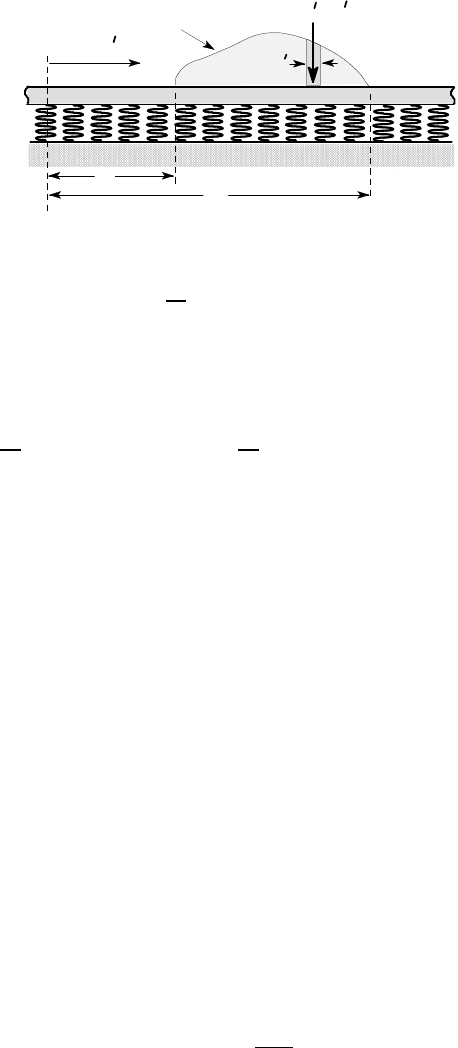
7.5 The particular solution 365
We obtain
u(z) = −
β
2k
Z
b
a
w(z
′
) f
3
(
β
|z −z
′
|)dz
′
. (7.38)
Be careful with the absolute value expression |z −z
′
|, particularly when evaluating
the displacement at a point in the range a < z < b. In fact, in this case it is safer to
split the range of integration to make the sign of (z −z
′
) explicit. We then obtain
u(z) = −
β
2k
Z
z
a
w(z
′
) f
3
[
β
(z −z
′
)]dz
′
−
β
2k
Z
b
z
w(z
′
) f
3
[
β
(z
′
−z)]dz
′
; a < z < b ,
since|z −z
′
|= (z
′
−z) when z
′
>z.
Equation (7.38) defines a general solution for the displacement of an infinite
beam subjected to a distributed load w(z), but this is not generally the most effi-
cient way of solving such problems, since the integrals tend to be algebraically com-
plicated. Instead, we usually account for a distributed load by seeking a particular
solution of equation (7.5), as will be discussed in the next section.
7.5 The particular solution
If the applied load w(z) is an elementary function, it is usually possible to determine
a particular solution to equation (7.5) by assuming a displacement function u(z) of
similar form. Special cases that can always be solved in this way include polynomial,
trigonometric and exponential functions.
Polynomials
If w(z) is a polynomial of degree n in z, a particular solution can always be obtained
by assuming u(z) to be another polynomial of the same degree, substituting into
equation (7.5) and equating coefficients. For polynomials of degree 3 and below, the
first (derivative) term in (7.5) degenerates to zero and we obtain the simple result
u(z) = −
w(z)
k
. (7.39)
O
δz
w(z)
w(z )δz
z,z
a
b
Figure 7.13: Infinite beam with a distributed load w(z)
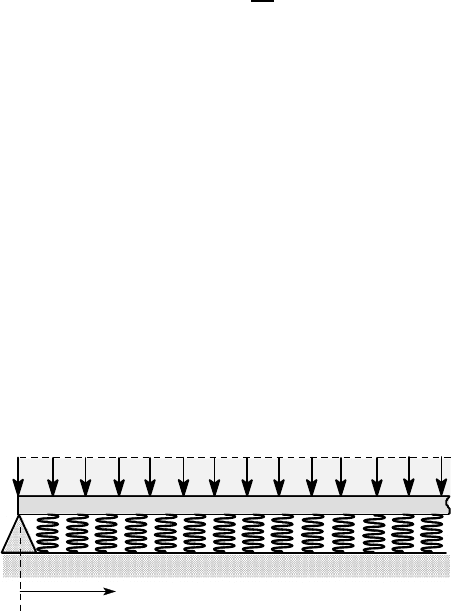
366 7 Beams on Elastic Foundations
Trigonometric and exponential functions
If the applied load is of the form w(z) = w
0
cos(az) [or w
0
sin(az)], a particular so-
lution can be obtained by assuming u(z) = u
0
cos(az) [or u
0
sin(az)] and equating
coefficients. This result is easily extended to more general periodic loading using
Fourier series.
A similar technique can be used for the exponential function w(z)=w
0
exp(az).
The more advanced reader will recognize that these results open the way to more
general procedures for determining particular solutions, using Fourier or Laplace
transforms.
7.5.1 Uniform loading
If a beam is subjected to a uniform load w(z)=w
0
throughout its length, the particular
solution
u(z) = −
w
0
k
(7.40)
satisfies equation (7.5) and corresponds to a state in which the beam simply moves
downwards as a rigid body to compress the support until an equal and opposite dis-
tributed support force is generated. In this case there will be no shear force or bending
moment in the beam and the particular solution will be the complete solution of the
problem if the ends of the beam are free and unloaded.
Equation (7.40) will not be the complete solution if the ends of the beam are
supported or if the load does not extend over the whole length of the beam. In such
cases, the solution is obtained by superposing the homogeneous solution of §7.2 to
correct the boundary conditions at the ends or at the ends of the loaded region.
Example 7. 2
Figure 7.14 shows a semi-infinite beam of flexural rigidity EI supported on an elastic
foundation of modulus k and simply supported at the end z=0. The beam is subjected
to a uniformly distributed load w
0
per unit length. Find the maximum bending mo-
ment in the beam.
Figure 7.14: Semi-infinite beam with a uniform load w
0
per unit length, supported at
the end
O
z
0
w per unit length
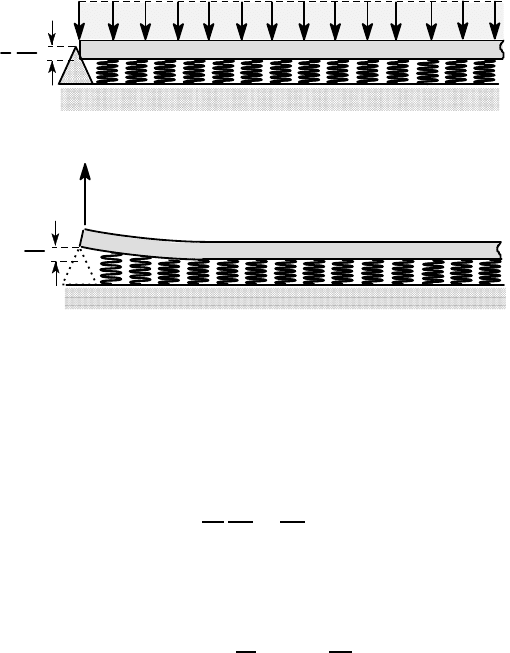
7.5 The particular solution 367
If there were no force at the support, the beam would fall until u(z) = −w
0
/k,
as in Figure 7.15 (a). To correct the end condition, we must superpose an upward
force F
0
at z = 0, as in Figure 7.15 (b). The force must be just sufficient to produce
an upward displacement u(0) = w
0
/k, so as to re-establish contact with the support.
Notice that no moment is applied at the end, since this is a simple support.
(a)
(b)
Figure 7.15: (a) The particular solution, (b) force at the support
In Example 7.1, we found that a downward force F
0
at the end of a similar semi-
infinite beam produced a displacement u(0)=−2
β
F
0
/k, so having regard to the sign
difference between Figures 7.5 and 7.15 (b), we conclude that
F
0
=
w
0
k
k
2
β
=
w
0
2
β
.
The particular solution produces no bending moment, so the maximum bending
moment is that due to the end force F
0
which from Example 7.1 is of magnitude
|M
max
| = 0.322
F
0
β
= 0.161
w
0
β
2
.
As before, it occurs at the point z=
π
/4
β
=
π
l
0
/4.
7.5.2 Discontinuous loads
If only part of the beam is loaded, we can make a cut in the beam at the discontinuity,
develop a particular solution for each segment and then apply loads to the ends of
each segment sufficient to restore continuity of displacement and slope.
0
w per unit length
u(z)=
k
w
0
k
w
0
F
0
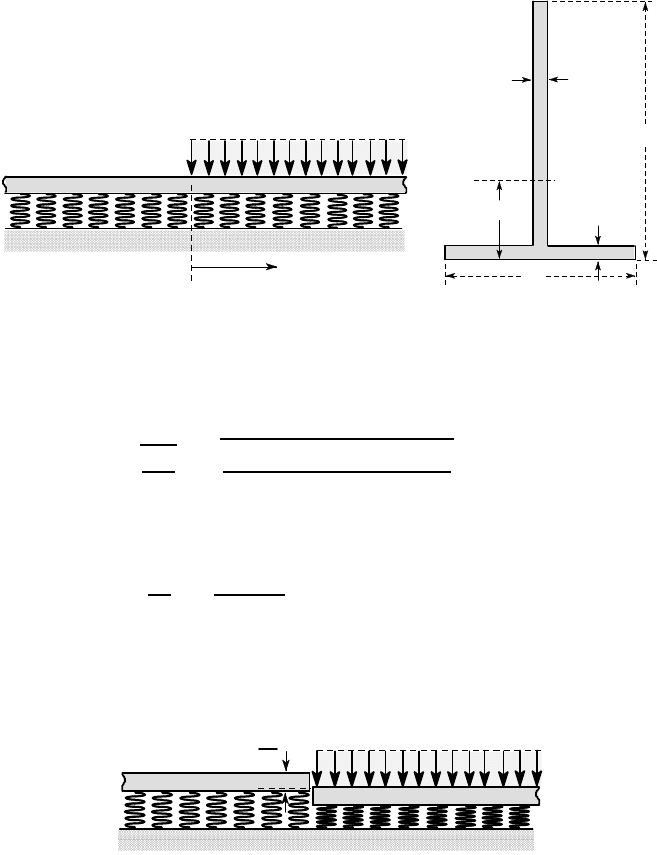
368 7 Beams on Elastic Foundations
Example 7. 3
A long T-section beam is supported on a Winkler foundation of modulus k =10 MPa
and subjected to a uniformly distributed load w(z) = w
0
= 50 kN/m in z > 0 only,
as shown in Figure 7.16 (a). The cross section of the beam and the location of the
centroid C are shown in Figure 7.16 (b). The appropriate second moment of area
is I
x
= 1.17 ×10
−6
m
4
and E = 210 GPa. Find the location and magnitude of the
maximum tensile stress in the beam.
5
5
110
33.7
80
C
.
all dimensions in mm
(a) (b)
Figure 7.16: (a) Infinite beam with a discontinuous load, (b) cross section of the
beam
We first calculate
β
=
4
r
k
4EI
=
4
s
10 ×10
6
4 ×210 ×10
9
×1.17 ×10
−6
= 1.786 m
−1
.
Suppose we now make a cut in the beam at z=0, permitting the segment z> 0 to
deflect to
u(z) = −
w
0
k
= −
50 ×10
3
10 ×10
6
= −5 ×10
−3
m (5 mm downwards).
The segment z < 0, being unloaded, will have no displacement and both beams will
move as rigid bodies, involving no bending moment and no loads on the cut ends.
The displacement produced by this process has the discontinuous form shown in
Figure 7.17.
Figure 7.17: Displacement of the cut beam
O
z
0
w per unit length
0
w per unit length
k
w
0
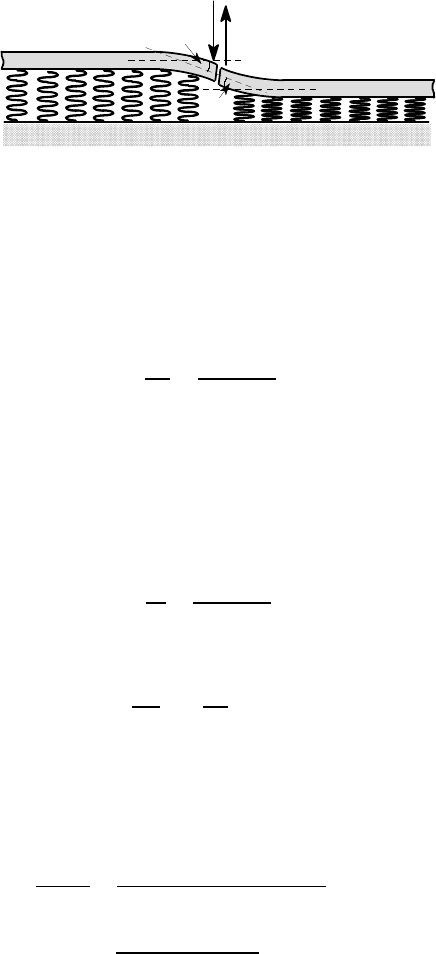
7.5 The particular solution 369
We now apply equal and opposite forces and moments to the cut ends of the two
segments, chosen so as to close the gap whilst preserving continuity of slope at z=0.
Since the two segments have similar properties, it is clear that equal and opposite
forces F
0
will produce equal slopes at the ends, as shown in Figure 7.18.
Figure 7.18: Slopes
θ
1
=
θ
2
for all values of F
0
Thus, no moments are required at the cut to preserve continuity of slope. Further-
more, the forces produce equal and opposite displacements on the two ends, each of
which must therefore have magnitude w
0
/2k to restore continuity of displacement.
This is half of the end displacement in the problem of Figure 7.15 (b) and hence the
required force is
F
0
= −V (0) =
w
0
4
β
=
50 ×10
3
4 ×1.786
N = 7.0 kN .
No bending moment is generated at z=0. It is a point of inflexion in the deformed
beam at which d
2
u/dz
2
= 0. The maximum bending moment therefore occurs either
in z > 0 or z < 0. Both beam segments are deformed in a similar manner — the load
w
0
in z > 0 merely causes a superposed rigid body displacement as in Figure 7.17.
The maximum bending moment in each segment is therefore the same and, as in
Example 7.1, we have
|M
max
| = 0.322
F
0
β
=
0.322 ×7
1.786
= 1.25 kNm .
The maximum positive moment occurs at
z = −
π
l
0
4
= −
π
4
β
= −0.44 m
(in the unloaded segment) and the equal maximum negative moment occurs in the
loaded segment at z=0.44 m.
The bending stresses at the top and bottom of the section at z = −0.44 m in the
unloaded segment are given by
σ
top
=
My
max
I
=
1.25 ×10
6
×(110 −33.7)
1.17 ×10
6
= 81.5 MPa
σ
bottom
= −
1.25 ×10
6
×33.7
1.17 ×10
6
= −36.0 MPa .
F
0
F
0
1
θ
2
θ
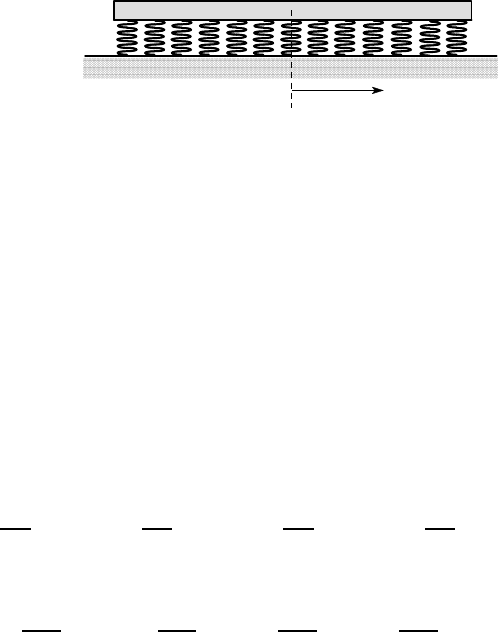
370 7 Beams on Elastic Foundations
These values are reversed in sign at z = 0.44 m in the loaded segment. We conclude
that the maximum tensile stress occurs in the unloaded segment at the top of the
section and is 81.5 MPa. As a check on the sign convention, we note from Figure
7.18 that the curvature of the beam will place the upper part of the section in tension
on the left and in compression on the right of the discontinuity.
7.6 Finite beams
We argued in §7.3 that in many cases a finite beam on an elastic foundation can be
treated as semi-infinite because the effects from one end will have decayed before
the other end is reached, leading to essentially uncoupled homogeneous problems for
the conditions at the respective ends. However, this decoupling requires that
β
L≫1,
where L is the length of the beam. If this condition is not satisfied, all four constants
in the homogeneous solution (7.11) must be retained and determined from four si-
multaneous equations, representing the two conditions at each end of the beam.
Figure 7.19: Coordinate system for the finite beam
In this case, it is generally more efficient to take advantage of the symmetry of
the finite beam by moving the origin to the mid-point, as shown in Figure 7.19, and
using the hyperbolic form (7.12) of the homogeneous solution, which we here restate
as
u(z) = C
1
g
1
(
β
z) +C
2
g
2
(
β
z) +C
3
g
3
(
β
z) +C
4
g
4
(
β
z) , (7.41)
where
g
1
(x) = cosh(x)cos(x) ; g
2
(x) = sinh(x)sin(x) ;
g
3
(x) = cosh(x)sin(x) ; g
4
(x) = sinh(x)cos(x) . (7.42)
Notice that g
1
,g
2
are even functions of x and g
3
,g
4
are odd functions, so in a sym-
metric or antisymmetric problem, only two of the four arbitrary constants need to be
included. The derivatives of these functions satisfy the relations
dg
1
dx
= g
4
−g
3
;
dg
2
dx
= g
3
+ g
4
;
dg
3
dx
= g
1
+ g
2
;
dg
4
dx
= g
1
−g
2
(7.43)
and
d
2
g
1
dx
2
= −2g
2
;
d
2
g
2
dx
2
= 2g
1
;
d
2
g
3
dx
2
= 2g
4
;
d
2
g
4
dx
2
= −2g
3
. (7.44)
z
O
z=L / 2
z=-L /
2
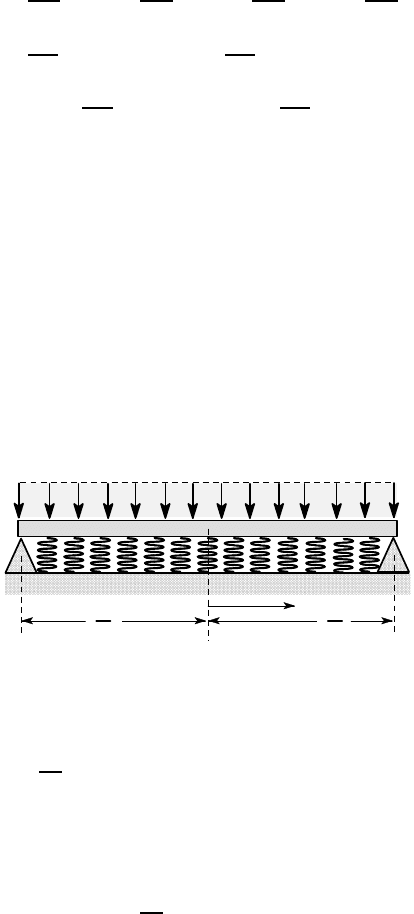
7.6 Finite beams 371
We can therefore write general expressions for the slope, bending moment and shear
force in the form
θ
(z) = C
1
β
[g
4
(
β
z) −g
3
(
β
z)] +C
2
β
[g
3
(
β
z) + g
4
(
β
z)]
+C
3
β
[g
1
(
β
z) + g
2
(
β
z)] +C
4
β
[g
1
(
β
z) −g
2
(
β
z)] (7.45)
M(z) =
C
1
k
2
β
2
g
2
(
β
z) −
C
2
k
2
β
2
g
1
(
β
z) −
C
3
k
2
β
2
g
4
(
β
z) +
C
4
k
2
β
2
g
5
(
β
z) (7.46)
V (z) =
C
1
k
2
β
[g
3
(
β
z) + g
4
(
β
z)] −
C
2
k
2
β
[g
4
(
β
z) −g
3
(
β
z)]
−
C
3
k
2
β
[g
1
(
β
z) −g
2
(
β
z)] +
C
4
k
2
β
[g
1
(
β
z) + g
2
(
β
z)] . (7.47)
The results are still considerably more algebraically complex than those for long
beams and there is justification in practical problems for using the semi-infinite beam
results as an order of magnitude approximation, even for values of
β
L as low as 3.
Example 7. 4
A beam of length L and flexural rigidity EI is supported on a foundation of modulus
k and also by two simple supports at the ends. It is loaded by a uniformly distributed
load w
0
per unit length as shown in Figure 7.20. Find the reactions at the supports
and the bending moment at the mid-point. Show that these results reduce to those
for a simply-supported beam with no elastic foundation when the beam is sufficiently
short.
We construct the solution as the sum of the particular solution (7.40) and the
homogeneous solution (7.41), i.e.
u(z) = −
w
0
k
+C
1
g
1
(
β
z) +C
2
g
2
(
β
z) +C
3
g
3
(
β
z) +C
4
g
4
(
β
z) .
However, the problem is symmetric about the origin and hence the solution must
satisfy the condition u(z)= u(−z), which requires that the constants C
3
=C
4
= 0.
We therefore have
u(z) = −
w
0
k
+C
1
g
1
(
β
z) +C
2
g
2
(
β
z)
O
z
0
w per unit length
L
2
L
2
Figure 7.20
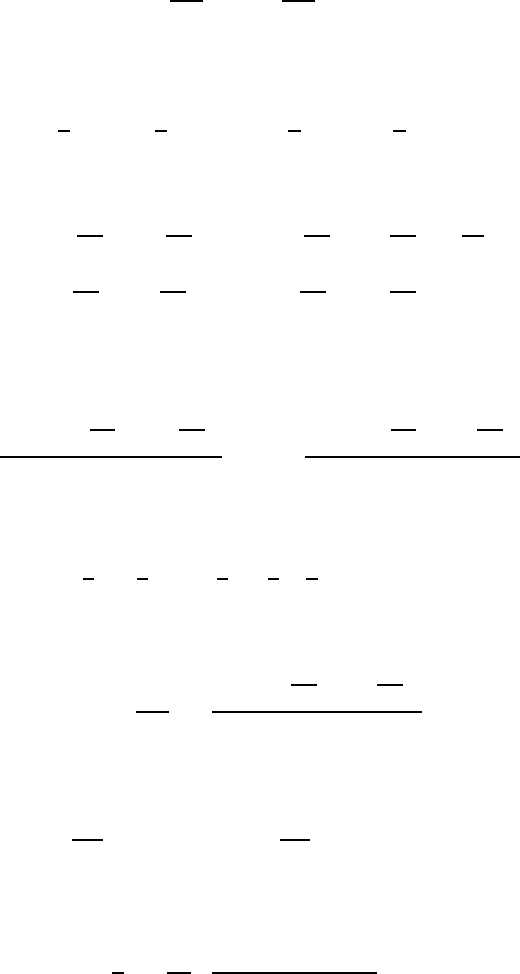
372 7 Beams on Elastic Foundations
and
M(z) =
C
1
k
2
β
2
g
2
(
β
z) −
C
2
k
2
β
2
g
1
(
β
z) ,
from (7.47).
The end conditions require
u
L
2
= u
−
L
2
= 0 ; M
L
2
= M
−
L
2
= 0
and hence
C
1
cosh
β
L
2
cos
β
L
2
+C
2
sinh
β
L
2
sin
β
L
2
=
w
0
k
C
1
sinh
β
L
2
sin
β
L
2
−C
2
cosh
β
L
2
cos
β
L
2
= 0 ,
using the definitions (7.42).
The solution of these simultaneous equations is
C
1
=
2w
0
cosh
β
L
2
cos
β
L
2
k
h
cosh(
β
L) + cos(
β
L)
i
; C
2
=
2w
0
sinh
β
L
2
sin
β
L
2
k
h
cosh(
β
L) + cos(
β
L)
i
,
where we have used the identity
cosh
2
x
2
cos
2
x
2
+ sinh
2
x
2
sin
2
x
2
=
1
2
(coshx + cosx) .
The bending moment at the mid-point (z=0) is
M(0) = −
C
2
k
2
β
2
= −
w
0
sinh
β
L
2
sin
β
L
2
β
2
h
cosh(
β
L) + cos(
β
L)
i
.
For the support reactions, we first note that
V (z) =
C
1
k
2
β
h
g
3
(
β
z) + g
4
(
β
z)
i
−
C
2
k
2
β
h
g
4
(
β
z) −g
3
(
β
z)
i
,
from (7.47). Substituting for C
1
,C
2
, using the definitions (7.42) and setting z = L/2
we have, after some simplification,
V
L
2
=
w
0
2
β
sinh(
β
L) + sin(
β
L)
cosh(
β
L) + cos(
β
L)
,
which is also the upward force at the support.

7.7 Short beams 373
In the limit
β
L≪1,
sinh(
β
L),sin(
β
L) →
β
L ; cosh(
β
L),cos(
β
L) → 1 ;
sinh
β
L
2
, sin
β
L
2
→
β
L
2
and we obtain
M(0) → −
w
0
β
L
2
2
2
β
2
= −
w
0
L
2
8
V
L
2
→
w
0
(2
β
L)
2
β
(2)
=
w
0
L
2
.
Both these results agree with the elementary bending theory for a beam on simple
supports with a uniformly distributed load. The elementary theory provides quite
a good approximation up to values of
β
L that are not strictly small. For example,
with
β
L = 1, the exact solution gives M(0) = −0.120w
0
L
2
which differs from the
elementary prediction by only 5%.
7.7 Short beams
We saw in the preceding example that when
β
L ≪1, the solution reduced to that
predicted by the elementary bending theory. In effect, the elastic deformations asso-
ciated with bending were very small and the corresponding support forces generated
by the foundation were negligible.
This will always be the case for a sufficiently short beam on an elastic foundation
if it is also kinematically supported, i.e. if there are rigid discrete supports at the ends
or elsewhere, sufficient to prevent rigid body motion if the elastic foundation were
removed. The solution is then very simple. Once we have verified that the beam
parameters satisfy
5
the condition
β
L ≪1, we just ignore the elastic foundation and
solve the remaining conventional beam problem.
If the beam is not kinematically supported, but still satisfies the condition
β
L ≪
1, the foundation forces can be determined by assuming that the beam translates
vertically and rotates as a rigid body. The unknown parameters defining this rigid
body motion are then found by requiring that the complete beam be in equilibrium.
An important special case concerns beam-like structures floating on the surface
of a liquid.
5
For practical purposes,
β
L <1 is generally sufficient to ensure that the approximation will
be sufficiently accurate.
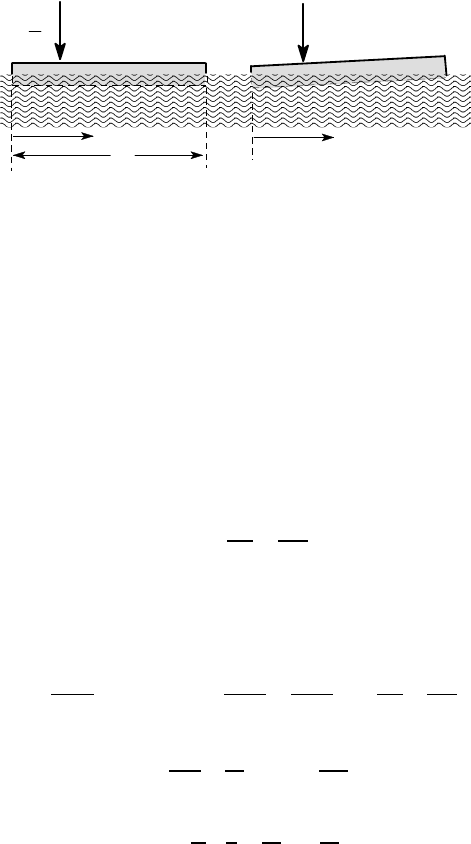
374 7 Beams on Elastic Foundations
Example 7. 5
Figure 7.21(a) shows a uniform rectangular beam of length L and weight W floating
on the surface of a liquid and loaded by a concentrated force F. Assuming that the
beam is short (
β
L ≪1), find the maximum bending moment in the beam. How large
a force F is required to cause one end of the beam to lift out of the liquid.
O
O
z
z
F
F
L
L
4
(a) (b)
Figure 7.21
We first treat the beam as a rigid body, in which case its displacement must be a
linear function of z — i.e.
u(z) = A + Bz ,
where A,B are unknown constants. Figure 7.21 (b) shows the displaced configuration
of the beam under load.
It follows that the buoyancy force must be
p(z) = k(A + Bz) ,
where k is a constant. If the beam is to be in equilibrium, we must have
F +W +
Z
L
0
p(z)dz = 0 ;
FL
4
+
W L
2
+
Z
L
0
zp(z)dz = 0 ,
where we follow the convention of defining u(z) positive upwards and hence p(z)
positive downwards [see Figure 7.3 (a)]. Substituting for p(z) and evaluating the
integrals, we obtain
kAL +
kBL
2
2
= −F −W ;
kAL
2
2
+
kBL
3
3
= −
FL
4
−
W L
2
,
with solution
A = −
5F
2kL
−
W
k
; B =
3F
kL
2
and
p(z) = −
F
L
5
2
−
3z
L
−
W
L
.
The beam will lift from the liquid if the predicted value of p > 0 and this will
occur first at z=L if F > 2W .
